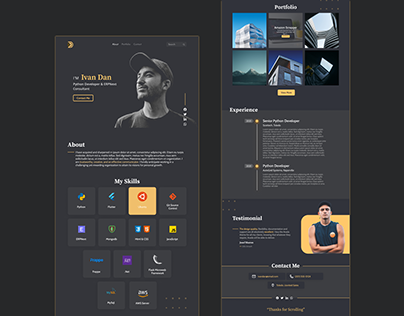Digital Insights
Your go-to source for the latest in technology and gadget reviews.
Portfolio Websites That Wow: Crafting Your Digital Showcase
Discover top tips for creating stunning portfolio websites that captivate and showcase your talent. Stand out online and impress potential clients!
Top 10 Features Every Impressive Portfolio Website Should Have
Creating an impressive portfolio website is essential for showcasing your work effectively. Here are the top 10 features that every impressive portfolio website should have:
- Clean and Professional Design - A visually appealing layout is crucial to make a first impression. Consider using white space and a cohesive color palette to enhance usability.
- High-Quality Images - Always use high-resolution images of your work. Poor quality visuals can detract from the quality of your portfolio and reflect poorly on your brand. Check out Canva for great design tips.
- Responsive Design - With more users accessing websites via mobile devices, ensure your portfolio is mobile-friendly. A responsive design adjusts seamlessly across different screen sizes.
- Clear Navigation - Make it easy for visitors to explore your work. Use a simple menu structure that quickly directs users to various sections of your portfolio.
- About Me Section - This section offers visitors insight into who you are. Share your story and what inspires you, fostering a connection with potential clients.
Continuing with the essential elements, consider incorporating the following features:
- Contact Information - Provide clear contact details. A dedicated contact page with a form or email address allows potential clients to reach you easily.
- Testimonials - Highlight feedback from previous clients. Authentic reviews can enhance your credibility and encourage new clients to work with you. Learn more about this on Forbes.
- Blog or Articles - Sharing insights or case studies through a blog can position you as an industry expert. This also contributes to your site's SEO strength.
- Social Media Links - Connect your portfolio to your social media profiles. This makes it easy for visitors to follow your work and engage with you across platforms.
- Search Engine Optimization (SEO) - Optimize your portfolio site for search engines using relevant keywords and meta descriptions, making it easier for potential clients to discover your work online.

How to Choose the Right Platform for Your Portfolio Website
Choosing the right platform for your portfolio website is essential to showcase your work effectively. Consider your technical skills first; platforms like Wix or Squarespace are user-friendly and ideal for beginners who prefer drag-and-drop features. However, if you possess coding skills or require more customization, options like WordPress can provide greater flexibility and control over your design and functionality.
Next, think about what features are crucial for your portfolio. Do you need built-in SEO tools, e-commerce capabilities, or social media integration? Make a list of the must-have features that align with your goals. For instance, if you’re an artist, consider platforms that allow high-quality image uploads and galleries, like Format. For those focusing on written content or photography, look for platforms that offer robust blogging capabilities or portfolio layouts, ensuring you can present your work in the best light possible.
What Makes a Portfolio Website Stand Out: Key Design Elements
A standout portfolio website is crucial for any creative professional seeking to showcase their work effectively. Key design elements contribute significantly to this goal. First and foremost, visual hierarchy plays a vital role; it guides visitors' eyes and directs attention to the most important aspects of your portfolio. Use larger images, bold fonts, and contrasting colors to highlight your best pieces. Additionally, visual hierarchy helps in making the website user-friendly, ensuring an intuitive navigation experience.
Furthermore, the incorporation of unique navigation elements can set your portfolio apart from the competition. Consider using interactive elements or a grid layout that is both visually appealing and easy to use. Another important aspect is the use of consistency in design elements like colors, fonts, and styles; these create a cohesive look that enhances your brand identity. To optimize your portfolio even further, ensure it's mobile-friendly and responsive, as highlighted by UX Design. This attention to detail can dramatically improve user engagement and help you stand out in your field.